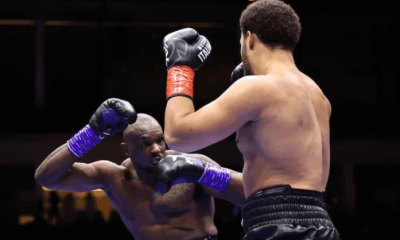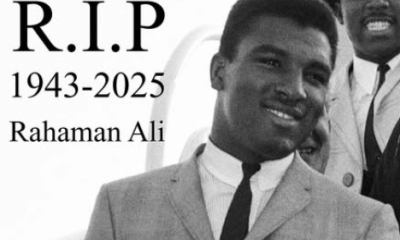Articles of 2006
“Beyond Glory” Captures Boxing’s Most Nationalistic Moment
Rocky IV is the highest grossing boxing movie ever made, not because it is the best, but because it captures the simplicity that Americans desire of boxing. The pugilistic representatives of two hostile nations determining supremacy in the ring is the sport at its rawest form. In reality, the closest boxing we have ever come to that is the 1938 rematch between our Joe Louis and Germany’s Max Schmeling. Yet as David Margolick’s Beyond Glory: Joe Louis vs. Max Schmeling and World on the Brink explains, the situation was much more complex.
The encyclopedia version of this story has been told countless times. That is, until he faced former heavyweight champ Schmeling at Yankee Stadium in June of 1936. While watching films of the Brown Bomber, Schmeling had exclaimed, “I zee zomething!” noticing that Louis dropped his right hand when he threw a left hook. During the second round of their initial bout, Schmeling landed a straight right to Louis’s chin. The Brown Bomber would spend the rest of the fight in a haze before falling for good in the 12th round.
In a perfect world, Schmeling would have then faced champion James J. Braddock, but escalated tensions between the United States and Germany and Louis’s superior drawing power prevented it. In June of 1937, Louis faced Braddock, knocking him out in eight rounds. By the time Schmeling and Braddock squared off in June of 1938, Germany had severely persecuted its Jewish population, sent troops into Rhineland, and annexed Austria. In what became a battle of nations, a much more polished Louis destroyed Schmeling in one round.
Fifteen months later, Germany invaded Poland, beginning World War II. Louis served in the United States Army, boxing exhibitions, Schmeling as a paratrooper in Germany’s Wehrmacht. Neither fired a single gunshot in battle. While the Nazi connection plagued him for the rest of his life, Schmeling did serve as an ambassador to boxing both in Germany and the United States and lived to be 99 years old. Louis held the title until 1949, paving the way for the black athlete in professional sports. Unfortunately, his life outside the ring was not as successful and he battled financial woes, drug addiction, and mental illness throughout much of his life. Despite their hatred in the ring, the two became friends after World War II. When Louis died in 1981, Schmeling paid for the funeral.
Of course, very few points in history can be summed up in three paragraphs, and inaccuracies can be repeated so many times that they become fact. Margolick’s narrative does a wonderful job recounting the years between 1935 and 1939. It also presents contrasts to many events thought to be fact. For instance, Schmeling may have claimed that he paid for Louis’s funeral, but Louis’s lawyer disputed that statement. According to Margolick, Schmeling was a bit of a revisionist historian.
The book also delves below the surface of many other preconceived notions that have stood for decades. Louis was certainly the first black fighter that Americans, as a whole, rallied around. However, bigotry still besieged the nation. As Margolick writes, when Schmeling knocked out Louis in 1936, “Cheers halted business in the [U.S.] House of Representatives for several minutes.” The situation was similar in the Senate as well.
Only after Louis won the title, and Americans were faced with the prospect of the heavyweight title going to Nazi Germany, did the nation throw its support to Louis. Still, the sportswriters of the era represent the country with their overtly and latently racist commentaries. As Lewis Achison of The Washington Post wrote after the Brown Bomber’s victory over Schmeling, “For all their misfortunes and shortcomings they are our people – Negroes, yes, but our Negroes.”
Even more boobish (and despicable) comments came out of the Nazi press, which Margolick gives a great deal of attention. One story never told is of Arno Hellmis, the Nazi sportscaster, who covered Schmeling's bouts with Louis, and was later killed covering Germany’s invasion of France. His coverage of both fights espoused Aryan supremacy. A disputed story is that Hellmis announced during the second fight’s broadcast that Jews are no more popular in the United States than they are in Germany.
But the most interesting person in the book is Schmeling, who walked a political tightrope throughout this period. The fact that he was a national icon in Weimar Germany, Nazi Germany, West Germany, and newly-unified Germany is a testament to his character and perseverance. Nevertheless, the notion that he spent the 1930s keeping his distance from the Third Reich is simply not true. He never joined the Nazi party but he most certainly hobnobbed with the evilest regime of the 20th century. At the same time, Schmeling also sheltered two Jewish boys from a pogrom in Kristallnacht in 1938. He also had a Jewish manager in Joe Jacobs, whose relationship with his own religious community suffered severely due to his loyalty to Schmeling.
Margolick’s illustration is that Schmeling was a survivor, and that his greatest crime was self-centeredness and little white lies. The fact that he glossed over his relationship with the Nazi party is of concern, but makes him no different than his fellow countryman. As Roger Kahn put it in 1961, “…Max, like 67 million other Germans, was never a Nazi. As I get the picture, there never more than five or six Nazis in Germany, but, of course, they worked very hard.” Nevertheless, Schmeling’s resurrection from de-facto war criminal to boxing statesman is quite fascinating.
Margolick, who has written about civil rights issues before (most notably in the book Strange Fruit: The Biography of a Song), does not seem out of his element with his narrative. Whether that is because he is a boxing aficionado is unclear. He certainly is an excellent researcher and that may explain his ease with the material.
While Margolick's prose is easy to read, the book is very detailed. Anyone who chooses to read this book will have to take his or her time doing so. Whoever does will receive a full account of one of the most painful growing periods in American history.
Margolick also provides many interesting footnotes of information, which brings a final note. For one of Schmeling’s U.S. tours in 1937, he had purchased a ticket to a flight scheduled to arrive in the United States on May 7. Jacobs insisted that he forgo the ticket and depart Germany earlier by boat. His scheduled flight was on the final trip of the Hindenburg, which blew up as it arrived in New Jersey. Thirty-six of the 97 passengers and crew died in the explosion. One of them was the recipient of Schmeling’s ticket.
-

 Featured Articles4 weeks ago
Featured Articles4 weeks agoThe Hauser Report: Zayas-Garcia, Pacquiao, Usyk, and the NYSAC
-

 Featured Articles3 weeks ago
Featured Articles3 weeks agoOscar Duarte and Regis Prograis Prevail on an Action-Packed Fight Card in Chicago
-

 Featured Articles2 weeks ago
Featured Articles2 weeks agoThe Hauser Report: Cinematic and Literary Notes
-

 Book Review2 weeks ago
Book Review2 weeks agoMark Kriegel’s New Book About Mike Tyson is a Must-Read
-

 Featured Articles4 weeks ago
Featured Articles4 weeks agoRemembering Dwight Muhammad Qawi (1953-2025) and his Triumphant Return to Prison
-

 Featured Articles6 days ago
Featured Articles6 days agoMoses Itauma Continues his Rapid Rise; Steamrolls Dillian Whyte in Riyadh
-

 Featured Articles3 weeks ago
Featured Articles3 weeks agoRahaman Ali (1943-2025)
-

 Featured Articles3 weeks ago
Featured Articles3 weeks agoTop Rank Boxing is in Limbo, but that Hasn’t Benched Robert Garcia’s Up-and-Comers













